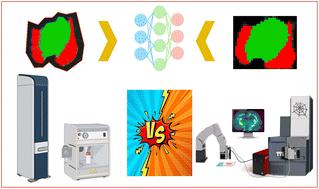Our official English website, www.x-mol.net, welcomes your
feedback! (Note: you will need to create a separate account there.)
Comparing MS imaging of lipids by WALDI and MALDI: two technologies for evaluating a common ground truth in MS imaging
Analyst ( IF 3.6 ) Pub Date : 2023-09-15 , DOI: 10.1039/d3an01096a Léa Ledoux 1 , Yanis Zirem 1 , Florence Renaud 2 , Ludovic Duponchel 3 , Michel Salzet 1, 4 , Nina Ogrinc 1 , Isabelle Fournier 1, 4
Analyst ( IF 3.6 ) Pub Date : 2023-09-15 , DOI: 10.1039/d3an01096a Léa Ledoux 1 , Yanis Zirem 1 , Florence Renaud 2 , Ludovic Duponchel 3 , Michel Salzet 1, 4 , Nina Ogrinc 1 , Isabelle Fournier 1, 4
Affiliation

|
In this study, we conducted a direct comparison of water-assisted laser desorption ionization (WALDI) and matrix-assisted laser desorption ionization (MALDI) mass spectrometry imaging, with MALDI serving as the benchmark for label-free molecular tissue analysis in biomedical research. Specifically, we investigated the lipidomic profiles of several biological samples and calculated the similarity of detected peaks and Pearson's correlation of spectral profile intensities between the two techniques. We show that, overall, MALDI MS and WALDI MS present very close lipidomic analyses and that the highest similarity is obtained for the norharmane MALDI matrix. Indeed, for norharmane in negative ion mode, the lipidomic spectra revealed 100% similarity of detected peaks and over 0.90 intensity correlation between both technologies for five samples. The MALDI-MSI positive ion lipid spectra displayed more than 83% similarity of detected peaks compared to those of WALDI-MSI. However, we observed a lower percentage (77%) of detected peaks when comparing WALDI-MSI with MALDI-MSI due to the rich WALDI-MSI lipid spectra. Despite this difference, the global lipidomic spectra showed high consistency between the two technologies, indicating that they are governed by similar processes. Thanks to this similarity, we can increase datasets by including data from both modalities to either co-train classification models or obtain cross-interrogation.
更新日期:2023-09-15















































 京公网安备 11010802027423号
京公网安备 11010802027423号